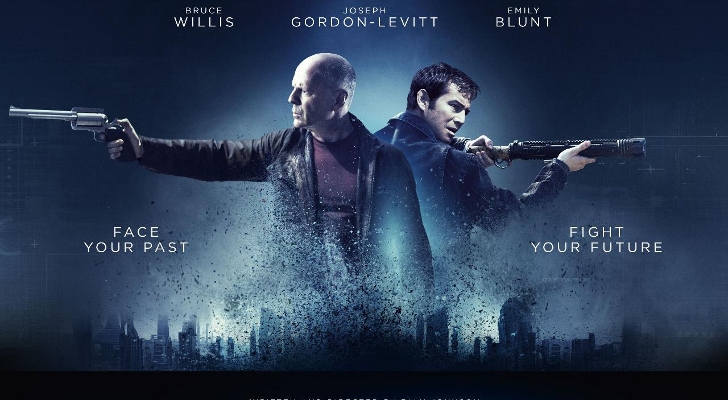
Rian Johnson’s third feature as writer-director is a knowingly daft though often serious science-fiction time travel yarn. Not as subversive or as funny as his first feature, Brick, nor as unfocussed as his second, the conman movie The Brothers Bloom, Looper is a defiant step closer to the mainstream, but with enough Rian-isms to keep fans interested.
Joseph Gordon-Levitt plays Joe, a mob hired gun in 2042. As the prologue explains in voiceover, a necessary act of bad screenwriting, Joe is a ‘looper’, a hit man who disposes of people who have been sent back from the future. In 2072, it will be practically impossible to get away with murder, so future gangsters send their victims back 30 years. When a looper has fulfilled his duty, he must ‘close the loop’ by killing his future self, take a big pay-off and enjoy the thirty years they have left. However, when Joe must unexpectedly close his own loop, he fails, allowing his future self (Bruce Willis) to escape.
The film sounds rather dodgy and the plot sounds like something that would be over-stretched inside thirty minutes. The film’s set-up is also problematic as there is a lot of information that has to be imparted before the main action can begin. However, the film gets by thanks to its sheer verve, something that is never lacking in a Rian Johnson film. The idea is silly but things are not always too serious and the whole thing moves along at a good, possibly too near choppy, speed. It is all buoyed by the quality of its ideas, of which there are a lot. The film can shock and/or horrify when it needs to, especially with a grim set-up sequence involving Seth (a shrill Paul Dano) and his future self, which pushes the film close to Cronenbergian body horror. As a result, the film rarely flags and is often really rather witty.
However, once Bruce Willis appears and then escapes, the film shifts gears, becoming a chase film with shades of drama. Then the horror movie strains are developed further. Before, the film felt primarily like Twelve Monkeys crossed with Goodfellas and Mean Streets – as a side note the film works quite well as a Scorsese-esque gangster film set in the future for as long as it cares to. A segue into The Terminator and The Omen is surprising and, admittedly, well orchestrated but it does give the film an oddly lop-sided feel in retrospect.
That said, and this is a constant theme in this review, the film gets away with it entirely thanks to the cleverness of its own conception and presentation. To name a few of the ideas that help the film along will spoil the surprise, so read no further if you intend to go and see the film without knowing too much about it – which is recommended. The aforementioned body horror sequence with Seth, which is horrible and incredibly inventive. Old Joe can track Joe as everything Joe does creates a new memory for Old Joe, who then merely re-traces his steps. An action sequence seen from two perspectives skilfully makes this clear and also has a lot of fun with it. The running joke about telepathy becoming only a pick-up tactic with annoying men which goes further than you’d think. One short scene in which Bruce Willis tries to recall his wife while his memories of her fade since it is becoming less and less likely that Gordon-Levitt’s Joe will ever met her. He remembers her thanks to a slap, gestures becoming temporal links and bridging different timelines and alternate realities. With the skill of an essay-filmmaker as great as Chris Marker, Rian Johnson brings up plot points alongside ideas about the nature of time, memory and experience, all with his customary brio. Finally, a subtle but somewhat innovative critical take on the action movie genre developed across juxtaposition and camera movement. First, a murder spree from Bruce Willis is left unseen as the camera focuses instead on a wall, slowly approaching a corner around which the carnage would be visible. Johnson teases our gory expectations while also radically refusing to show anything, refusing to glorify Willis’ violence or to show that it can do any good (a conclusion borne out by the film’s ending). Similarly, we don’t see the final confrontation between Willis and bad guy Jeff Daniels, only the aftermath. Second, and more subtly, we see a child (Pierce Gagnon) with blood all over his face. The thrust of the narrative makes us think him deeply sinister and to even urge Gordon-Levitt to kill him. However, following Willis’ killing spree, he is similarly seen with blood all over his face, though now we have been positioned to see him as heroic rather than sinister. The film very cleverly mocks our twisted ideas of moral and amoral violence, showing violence as only damaging no matter from which side it comes. The end of the film reaffirms this with a humanist ending which emphasises free will and risk over inhumane violence and certainty, all without moralising.
Whether the above reading is convincing or not, Looper remains, nevertheless, a surprising and somewhat complex work. At the risk of sounding repetitive, the film is packed with interesting ideas and clever conceits. Aside from being a lot of fun, the film is inventive and imaginative, a too rarely found thing in semi-mainstream American cinema. It is not without its flaws and distractions – Piper Perabo having nothing to do but presumably fulfil some sort of stodgy nudity quota; Emily Blunt’s character shifting to fit the plot’s twists and turns; Willis’ acting only rarely being up to scratch; Gordon-Levitt’s make-up. However, the film ends up developing enough good will to see it through.
No comments:
Post a Comment